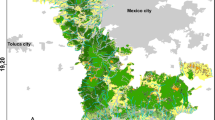Understanding patterns of speciesl habitat use and their response to dramatic changes in habitat constitutes a basis for sound conservation practice. This study examined use of breeding habitat by two rainforest-breeding frog species near primary forest edge. Nine artificial breeding pools were established along each of three transects perpendicular to continuous primary forest near Manaus, Brazil. Five frog species bred in the pools over the six-month monitoring period. For the two most abundant species, patterns of habitat use were independent of proximity to forest edge. Also,Epipedobates femoralis used pools outside the forest, in secondary growth, at the same frequency as pools inside the forest.Osteocephalus taurinus did not breed outside primary forest. These results have clear implications for conservation biology: (i) buffer zones around isolated reserves, to counter possible negative edge effects on habitat, are unnecessary for these frog species, and (ii) secondary growth habitat, which is not ‘natural’ breeding habitat forE. femoralis, could serve as a source of colonists for emigration into new areas and does not represent a barrier to dispersal for this species. These results argue against generalization of edge effects for different taxa.
Similar content being viewed by others
References
Andren, H. and Angelstam, P. (1988) Elevated predation rates as an edge effect in habitat islands; experimental exidence.Ecology 69, 544–7.
Bierregaard, R.O. and Lovejoy, T.E. (1988) Birds in Amazonian forest fragments; effects of insularization. InActa XIX Cong. Intl. Ornith. (M., Ouellet, ed.) pp. 1564–79. Ottawa: University of Ottawa Press.
Blouin, M.S. and Connor, E.F. (1985) Is there a best shape for nature reserves?Biol. Conserv. 32, 277–88.
Brittingham, M.C. and Temple, S.A. (1983) Have cowbirds caused songbirds to decline?BioScience 33, 31–5.
Diamond, J.M. (1975) The island dilemma: lessons of modernbiogeographic studies for the design of natural reserves.Biol. Conserv. 7, 129–46.
Diamond, J.M. and May, R.M. (1976) Island biogeography and the design of natural reserves. InTheoretical Ecology (R.M., May, ed.) pp. 163–86. Philadelphia: Saunders.
Duellman, W.E. (1978) The biology of an equatorial herpetofauna in Amazonian Ecuador.Misc. Publ. Mus. Nat. Hist. Univ. Kansas 65, 1–352.
Game, M. (1980) Best shape for natural reserves.Nature 287, 630–2.
Gascon, C. (1991) Population and community level analyses of species occurrences of central amazonian rainforest tadpoles.Ecol. 72, 1731–46.
Gosner, K.L. (1960) A simplified table for staging Anuran embryos and larvae with notes on identification.Herpetol. 16, 183–90.
Harris, L.D. (1988) Edge effects and conservation of biotic diversity.Conserv, Biol. 2, 330–2.
Janzen, D.H. (1983) No park is an island: increase interference from outside as park size decreases.Oikos 41, 402–10.
Janzen, D.H. (1986) The eternal external threat. InConservation Biology (M., Soulé, ed.) pp. 286–303. Sunderland, Massachussets: Sinauer Publications.
Johnston, V.R. (1947) Breeding birds of the forest edge in Illinois.Condor 2, 45–53.
Kapos, V. (1989) Effects of isolation on the water status of forest patches in the Brazilian Amazon.J. Trop. Ecol. 5, 173–85.
Levenson, J.B. (1981) Woodlots as biogeographic islands in Southeastern Wisconsin, InForest islands in man-dominated landscapes (R.L., Burgess and D.M., Sharpe, eds) pp. 13–39. New York: Springer-Verlag Inc.
Lovejoy, T.E., Bierregaard, R.O., Rylands, A.B., Malcolm, J.R., Quintela, C.E., Harper, L.H., Brown, K.S., Powell, A.H., Powell, G.U.N., Schubart, H.O.R. and Hays, M.B. (1986) Edge and other effects of isolation on Amazon forest fragments, InConservation Biology (M., Soulé, ed.) pp. 257–85. Sunderland, Massachussets: Sinauer Publications.
Piper, J.K. (1986) Effects of habitat and size of fruit display on removal ofSmilacena stellata (Liliaceae) fruits.Can. J. Bot. 64, 1050–54.
Ranney, J.W., Bruner, M.C. and Levenson, J.B. (1981) The importance of edge in the structure and dynamics of forest islands. InForest islands in man-dominated landscapes (R.L., Burgess and D.M., Sharpe, eds) pp. 67–95. New York: Springer-Verlag Inc.
Roth, R.R. (1976) Spatial heterogeneity and bird species diversity.Ecology 57, 773–82.
Schonewald-Cox, C.M. and Bayless, J.W. (1986) The boundary model: a geographical analysis of design and conservation of nature reserves.Biol. Conserv. 38, 305–22.
Temple, S.A. (1986) Predicting impacts of habitat fragmentation on forest birds: A comparison of two models. InWildlife 2000 (J., Verner, M.L., Morrison and C.J., Ralph, eds) pp. 301–4. Madison, Wisconsin: University of Wisconsin Press.
Thomas, J.W., Maser, C. and Rodiek, J.E. (1978) Edges: their interspersion, resulting diversity and its measurement. InProceedings of a Workshop on Nongame Bird Habitat Management in the Coniferous Forests of the Western United States (R. DeGraaf, ed.) pp. 91–100. USDA Forest Service General Technical Report PNW64.
Whitcomb, R.F., Lynch, J.F., Opler, P.A. and Robbins, C.S. (1976) Letter to the editor,Science 193, 1030–32.
Wilcove, D.S., McLellan, C.H. and Dobson, A.P. (1986) Habitat fragmentation in the temperate InConservation Biology (M., Soulé, ed.) pp. 237–56. Sunderland, Massachussets: Sinauer Publications.
Wilcox, B.A. and Murphy, D.D. (1985) Conservation strategy: the effects of fragmentation on extinction.Am. Nat. 125, 879–87.
Williamson, M.H. (1975) The design of wildlife reserves.Nature 256, 519.
Willis, E.O. (1984) Conservation, subdivision of reserves and the anti-dismemberment hypothesis,Oikos 42, 396–8.
Wilson, E.O. and Willis, E.O. (1975) Applied biogeography. InEcology and evolution of communities (M.L., Cody and J.M., Diamond, eds) pp. 522–34. Cambridge, Massachussets Harvard University Press.
Yahner, R.H. (1988) Changes in wildlife communities near edges.Conserv. Biol. 2, 333–9.
Zimmerman, B.L. and Bierregaard, R.O. (1986) Relevance of the equilibrium theory of island biogeography and species-area relations to conservation, with a case from Amazonia.J. Biogeog. 13, 133–43.
Author information
Authors and Affiliations
Rights and permissions
About this article
Cite this article
Gascon, G. Breeding-habitat use by five Amazonian frogs at forest edge. Biodivers Conserv 2, 438–444 (1993). https://doi.org/10.1007/BF00114045
Received:
Accepted:
Issue Date:
DOI: https://doi.org/10.1007/BF00114045




